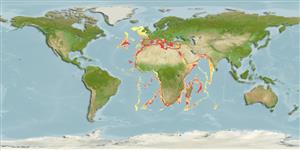Common names from other countries
Classification / Names / Names
Common names | Synonyms | Catalog of Fishes (gen., sp.) | ITIS | CoL | WoRMS
Environment: milieu / climate zone / depth range / distribution range
Ecology
Benthic; depth range 80 - 3300 m (Ref. 127635), usually 350 - 800 m (Ref. 80214). Tropical, preferred 19°C (Ref. 107945); 49°N - 30°S, 41°W - 75°E
Eastern Atlantic, Mediterranean and Western Indian Ocean: from Brazil to France, south to Natal, South Africa and east to Maldives.
Length at first maturity / Size / Weight / Age
Maturity: Lm 3.2 range ? - ? cm Max length : 22.0 cm TL male/unsexed; (Ref. 8); 7.1 cm CL (female); max. reported age: 6 years (Ref. 80242)
Demersal (Ref. 80214). Maximum length for females from Ref. 80234.
Life cycle and mating behavior
Maturity | Reproduction | Spawning | Eggs | Fecundity | Larvae
Members of the order Decapoda are mostly gonochoric. Mating behavior: Precopulatory courtship ritual is common (through olfactory and tactile cues); usually indirect sperm transfer.
Holthuis, L.B. 1980. (Ref. 8)
IUCN Red List Status (Ref. 130435: Version 2024-1)
CITES status (Ref. 108899)
Not Evaluated
Not Evaluated
Human uses
Fisheries: highly commercial
FAO - Fisheries: landings, species profile | FIRMS (Stock assessments) | FishSource | Sea Around Us
Tools
Internet sources
Estimates based on models
Preferred temperature
(Ref.
115969): 6.6 - 18.3, mean 13.3 (based on 351 cells).
Resilience
High, minimum population doubling time less than 15 months (K=0.14-0.99; tmax=6).
Prior r = 0.66, 95% CL = 0.44 - 0.99, Based on 7 full stock assessments.
Vulnerability
Low to moderate vulnerability (29 of 100).
